Scientists studying marine animals at the Florida Museum of Natural History seem to be living the high life, heading to the coast for fishing trips in the name of research.
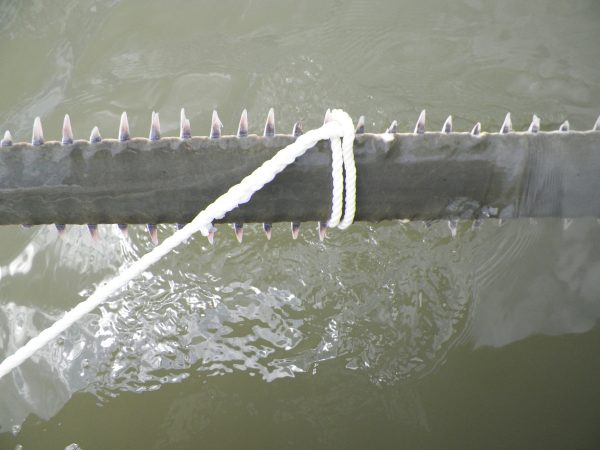
Photo by Jim Wilcox
But when you take away the refreshments, the relaxation most people associate with going fishing and consider they’re looking for one of the most rare and dangerous animals in Florida’s waters, being on a boat takes on a new meaning.
Tasked with developing a conservation plan for the federally endangered small-toothed sawfish, researchers have been attempting to track their movement patterns since 2010. But until their last trip in late March that resulted in eight tagged individuals, they had only hooked a few of the massive creatures in the Florida Bay.
“I was pretty surprised, I mean we caught one a day, and on two days, we caught two a day,” said marine biologist Yannis Papastamatiou, who is responsible for placing tracking devices on the animals. “And on one of those days, we caught two at exactly the same time.”
The crew is often accompanied by George Burgess, director of the Florida Program for Shark Research at the Florida Museum, but Burgess spent this trip nursing sawfish wounds inflicted during a previous excursion in Florida Bay.
“It’s hard work, that’s the first order of business,” Burgess said. “These are 13- to 15-foot animals and they have to be brought in by hand. We’re using a rod and reel to be as least intrusive as possible, and that means somebody’s got to haul that big animal to the boat – it’s a big fight.”
Of course, the waiting game of fishing for a rare species allows for a certain amount of down time – and the banter that comes with it.
“We caught one that we had nicknamed ‘stub nose’ or ‘stubby’ because he had half a rostrum,” said research assistant Bethan Gillett. “It was three days later when we re-captured him about eight miles away from where we first found him.”
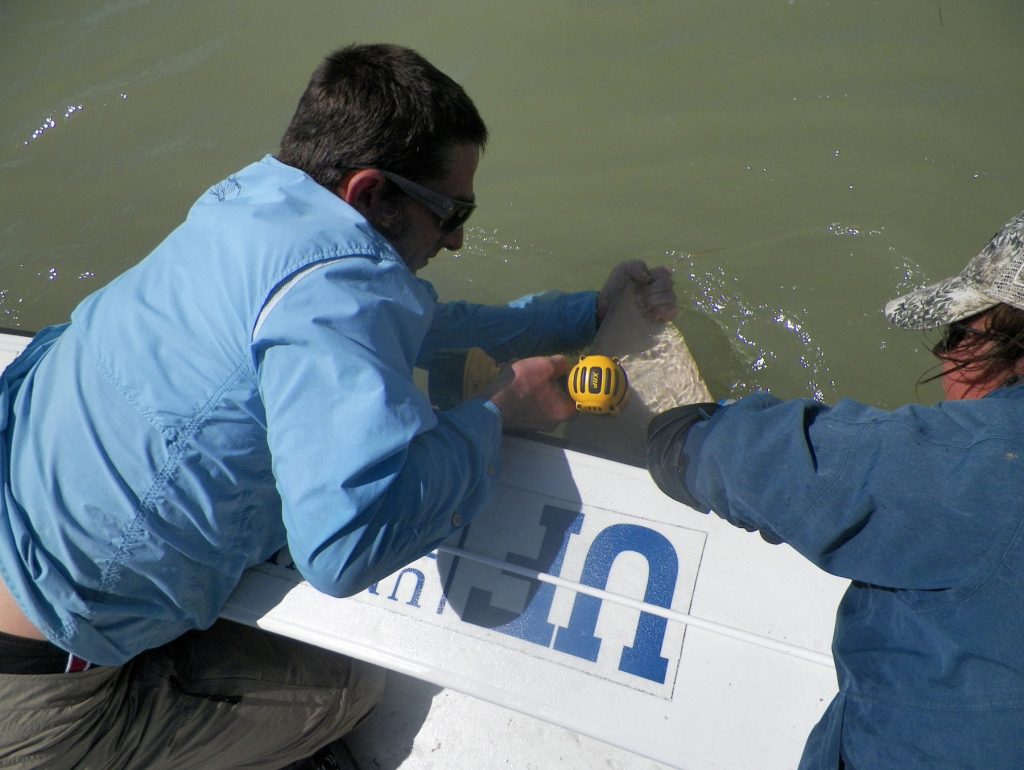
Florida Museum photo by Jim Wilcox
Because they are a rare species with no particular economic value, sawfish have not received the same level of scientific research given to many other animals, Burgess said. Given their endangered status, researchers cannot dissect sawfish specimens to understand their biology, and instead must use non-invasive methods.
“They never were extremely abundant because in the grand scheme of things, the largest animals tend to be found in the fewest numbers,” Burgess said. “Their habitat choices and where and when they’re found becomes additionally important and it tells us something about what they’re eating and what their reproductive cycle may be in order to develop a reasonable management plan.”
Reaching up to 25 feet in length and often found in shallow waters, sawfish are the largest marine fish that most people can sight off of Florida’s coast. Their history dates back hundreds of millions of years and their decline – largely the result of over-fishing – has slipped past scientists in the last 100 years, Burgess said.
“This critter is particularly threatened here in the United States,” he said. “Its sole remaining population is centered in southern Florida, so we as Floridians, above and beyond our national interest, have a very special obligation to save this animal.”
The chase
Every day during the week of March 26, rods and reels in hand, four Museum researchers and a fishing guide took two flat-bottomed boats to the southernmost tip of Florida, the Florida Bay in Everglades National Park.
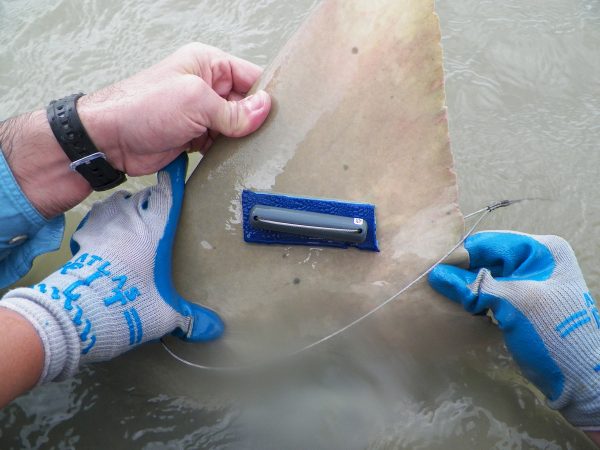
Photo by Jim Wilcox
In the mornings, they hunted ladyfish to use as sawfish bait. Basking in the Florida sun and the salty air, fishing for bait can be relaxing when compared with the real mission of attracting sawfish, Gillett said.
Around 11 a.m., the crew would switch gears and renowned guide captain Jim Wilcox led the boats to sawfish hotspots between tiny islands and sandbars.
“The Hell’s Bay boat is the perfect boat for that location because it can go into really shallow waters,” Gillett said of the 18-foot shark-themed flats boat donated to the Florida Program for Shark Research in 2010 by the Guy Harvey Ocean Foundation and Hell’s Bay Boatworks Inc.
The shark-riddled, mangrove-spotted waters are murky, and the crew can only determine if they’ve hooked a sawfish based on the feel of the reel.
“You know you have a sawfish on because they act a certain way – they tend to swim against the current, whereas sharks swim with the current once they are hooked,” said Gillett, known as the crew’s prized catcher. “They try to pull toward the bottom and you can also feel the swinging of their rostrum. They’re really, really strong, so it makes for an exciting fight.”
After pulling the fish close to the boat, crew members restrain it by tying lines around its tail and saw, or rostrum.
“Getting a line around the rostrum is the trickiest part, I think,” Papastamatiou said. “It’s a 1-meter-long blade thrashing around.”
After it is restrained, Papastamatiou sticks three different tags onto the animal: a standard dart tag for identification, a passive acoustic tag and a satellite transmitter.
Used to understand localized movement, the passive acoustic tag is detected by seven strategically placed underwater stations that record the time and place a sawfish swims near one. It’s an improvement from last year’s active acoustic tags, which required the crew to follow the sounds of the tag through the night using a hydrophone, Burgess said.
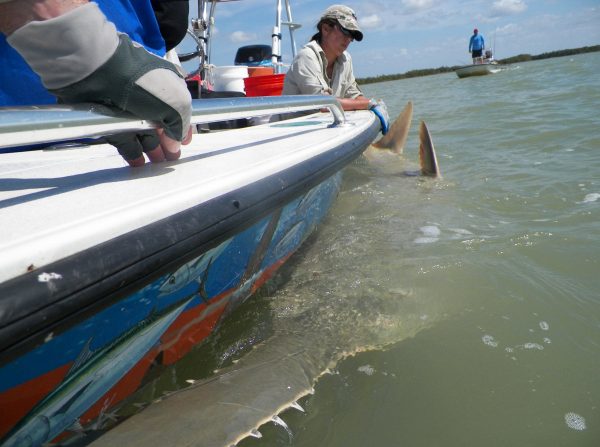
Photo courtesy of Jim Wilcox
“With these underwater receivers, we’re going to be able to gain a real appreciation of smaller-scale movement within Florida Bay to see what these guys are doing while they’re in the Bay during that portion of the year, or their life – whatever it may prove to be,” Burgess said. “It gives us valuable insight into localized movements and habitat choices, important factors in recovery planning.”
The satellite transmitter tags detach from the sawfish after three months and send information about the water’s depth, temperature and light levels. Together, researchers hope the information from the tags will paint a picture about their fine spatial range and movement over long time frames to understand their basic biology.
“The ultimate goal of course is that we want the population of the small-toothed sawfish to return to its former size,” Burgess said. “Right now, based on projections, that’s a 100-year process.”
Furthering research
The unique, serrated sawfish snout makes it a popular item for many bars and restaurants to mount on their walls, and the population decline has undoubtedly been accelerated by human interactions, Burgess said. Historically, their territory ranged from New York to Texas, but they are now only sighted off Florida’s coasts.
For Burgess, seeing a sawfish is a “life-moving experience” every time, he said.
“I think it’s safe to say most people who come across them echo the same sentiment, and there is a feeling of being blessed that you’ve had an opportunity to see this archaic critter, which obviously is so rare and endangered,” he said. “I suppose there’s a certain feeling of reverence while you’re next to it and you’re doing the work on it, because it’s a real marvel of evolution this animal developed the way it did and that it’s still with us after millions of years.”
Once a sawfish has been successfully tagged and returned to the water, an enormous feeling of satisfaction seems to pass through every crew member.
“The fact is, they’re magnificent animals,” Burgess said. “Their sheer size and strength of course are undeniable. The scars on my hand emphasize how dangerous they can be and why we need to be careful when dealing with them, because they really use that saw as an armed weapon.”
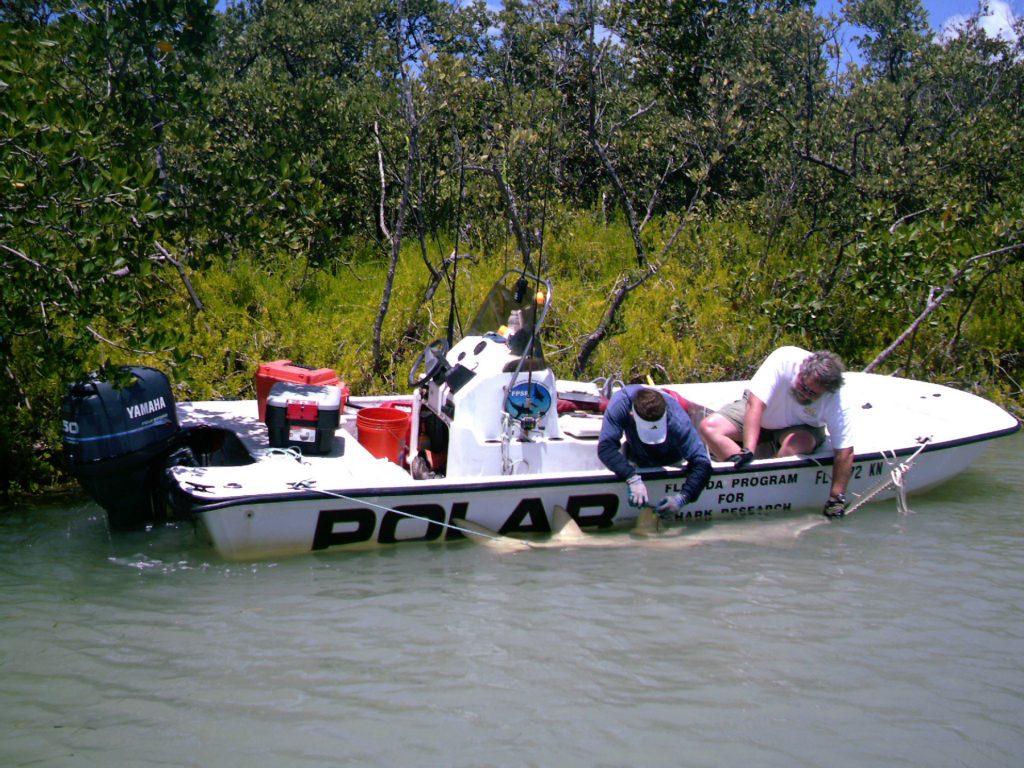
Photo courtesy of the Florida Program for Shark Research
Much of the habitat information accumulated by the research team has been gathered from the Florida Program for Shark Research’s International Sawfish Encounter Database, a record of all known sawfish sightings. Sawfish encounter forms and guidelines for safe release may be accessed at floridamuseum.ufl.edu/sawfish.
“Understanding their habitat use will help us understand where interactions with humans might occur,” Papastamatiou said. “Of course, we’re reliant on the public encounters to get a picture of sawfish distribution.”
Since they are an endangered species, working with sawfish requires a permit, and it allows researchers to tag 12 individuals per season. With one more field trip planned this spring, and nine already tagged, the team is well on its way to meeting the quota.
“The success of the second trip was so good that we’re going to be limited in what we do for the third trip,” Burgess said. “This was a big–timer – it was the most adult sawfishes that have been tagged in a short period of time in the Atlantic.”
Learn more about the Ichthyology Collection at the Florida Museum